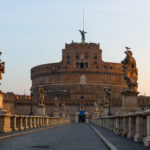Spring Grove Cemetery and Arboretum Mausoleums
Spring Grove Cemetery and Arboretum in Cincinnati, Ohio is one of the nation’s finest examples of rural garden cemeteries dating to the mid-19th century. Spanning 733 acres, of which approximately 450 are currently developed, Spring Grove is the second largest cemetery in the United States. In 2007, Spring Grove was designated a National Historic Landmark. Originally “Spring Grove Cemetery,” the governing association changed its name to “Spring Grove Cemetery and Arboretum” in 1987 to recognize its extensive collection of native and exotic trees.
History and Development of Spring Grove Cemetery and Arboretum
Spring Grove was chartered in 1845, when members from the Cincinnati Horticultural Society formed a cemetery association with the intention of developing a beautiful and contemplative rural cemetery. Spring Grove Cemetery drew upon contemporary rural cemeteries, including Pére Lachaise Cemetery in Paris and Mount Auburn Cemetery in Cambridge, as inspiration for the garden cemetery. The first interment took place on September 1, 1845.
In 1855, the cemetery hired Adolph Strauch, a renowned landscape architect, to renovate the grounds. He created a lawn plan designed to harmonize with nature, that at the time was considered quite unconventional. Later, however, the lawn plan was accepted as a common model for cemeteries. Strauch’s landscaping plan was designed to follow the natural shapes of Spring Grove’s hills and valleys, with lakes, islands, footbridges, and woodland areas harmonizing to create a beautiful and contemplative eternal resting place for its inhabitants.
Cemetery Services at Spring Grove
Spring Grove Cemetery provides an array of interment options to Cincinnati residents. Families and individuals select among:
- Cremation spaces and gardens
- Community mausoleums containing crypts and niches
- Lawn level spaces
- Family estate lots
- Monumental lots
- Private family mausoleums
Spring Grove Cemetery and Arboretum prides itself on serving Cincinnati residents with dignity and compassion, whether families are pre-planning or dealing with an immediate need.
Historic Private Mausoleums at Spring Grove Cemetery
In the nearly 170 years since its founding, Spring Grove Cemetery and Arboretum has become home to a wide array of noteworthy and historic private family mausoleums, including:
- Burnet Mausoleum: The Burnet Mausoleum, with its facade of imported Italian marble vault, is a classical example of Baroque style architecture. Designed by Charles Rule for the Burnet family, this private family mausoleum was completed in 1865. At that time, Judge Jacob Burnet’s remains were disinterred and placed in the newly completed mausoleum. His wife and son rest there with him today.
- Fleischman Mausoleum: The Fleischman Mausoleum was designed by William Salway, the superintendent of Spring Grove Cemetery, in 1913. This miniaturized, peristyled Doric Temple, combined with the plantings and the lake that surround it, creates a picture reminiscent of the famous English garden at Sourhead.
- Dexter Chapel Mausoleum: This Gothic Revival combination chapel and mausoleum, designed by architect James Keyes Wilson from 1865 to 1869, cost $100,000 to construct. This private mausoleum for the Dexter brothers was quite extravagant for its time, but today is one of the most beautiful buildings in Cincinnati and a centerpiece for Spring Grove Cemetery. Unfortunately, the materials used in its design have plagued it with structural problems that means the Dexter Chapel Mausoleum is in a constant state of decay and deterioration.
Spring Grove Cemetery and Arboretum provides a serene and beautiful final resting place to its inhabitants. As one of the nation’s foremost rural garden cemeteries, the design, landscaping, and integration of natural beauty makes Spring Grove Cemetery a noteworthy historical site and visitor destination.
